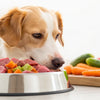How Much Raw Food Per Pound of Dog: A Comprehensive Guide for Pet Owners
- Houndsy
Table of Contents
- Introduction
- The Raw Food Revolution: Understanding the Basics
- Determining Your Dog's Ideal Body Weight
- Understanding the Components of Raw Food
- Transitioning to Raw Food
- Common Mistakes to Avoid
- FAQs on How Much Raw Food Per Pound of Dog
- Conclusion
Introduction
Did you know that the right diet could add several years to your dog's life? It's true! A proper balance of nutrition not only supports their overall health but can also positively impact their energy levels, coat quality, and even emotional well-being. For many pet owners, the raw food diet has become a popular choice, with proponents claiming fantastic benefits. However, a common question lingers among dog lovers: how much raw food per pound of dog should you feed?
As the raw food movement gains traction, particularly among design-conscious pet parents who care deeply about their pets' well-being, understanding how to balance nutrient-rich meals effectively becomes paramount. In this comprehensive guide, we will explore the foundational aspects of feeding raw food to dogs, addressing critical factors like weight, activity level, and overall health.
By the end of this post, you’ll feel empowered to tailor your dog's raw food intake according to their unique needs. We aim to clarify the ideal food volume and spark some thought regarding your existing feeding routines. Let’s dive in!
The Raw Food Revolution: Understanding the Basics
The raw food diet for dogs—often dubbed the BARF diet (Biologically Appropriate Raw Food)—emphasizes a natural approach, mimicking what canines would eat in the wilderness. Dogs are instinctually wired to consume a diet rich in protein and devoid of fillers, commonly found in commercial dog food.
1.1 Benefits of a Raw Food Diet
Pet parents around the globe are opting for raw diets due to the perceived advantages:
- Improved health: Many anecdotal reports suggest that dogs on a raw diet experience fewer allergies, improved digestion, better dental health, and shinier coats.
- Weight management: The lack of fillers means dogs often feel fuller faster, thus helping to control their weight.
- Customization: Owners can tailor ingredients to meet their dogs’ specific requirements, including those with allergies or sensitivities.
Adopting a raw food diet also offers a unique opportunity to bond with your dog through meal preparation—those moments spent prepping fresh food together can strengthen that essential human-animal connection.
1.2 Factors Affecting Raw Food Intake
It’s crucial to understand that not all dogs are created equal. Several factors affect how much raw food to feed per pound of dog, including:
- Age: Puppies need more food relative to their body weight compared to adult dogs, who require fewer calories per pound.
- Activity level: An active dog will need more calories than a less-active dog, which directly impacts how much raw food you should feed them.
- Health status: Underlying health issues may necessitate adjustments to their diet and caloric intake.
1.3 Calculating Raw Food Needs
To simplify the process of determining how much raw food per pound of dog, a baseline guideline often cited is to feed approximately 2–3% of a dog's ideal body weight daily. For example, if your dog weighs 50 pounds, you would provide 1 to 1.5 pounds of raw food each day, divided into two meals.
Now, let’s break down our knowledge into actionable steps for optimal raw feeding.
Determining Your Dog's Ideal Body Weight
Before calculating the amount of raw food, it’s essential to know your dog’s ideal weight.
2.1 Know Your Dog’s Current Weight
Start by weighing your dog. Make adjustments based on their breed, size, and build. Let's consider the following:
| Dog Weight (lbs) | Rough Daily Intake (2-3%) |
|---|---|
| 10 | 0.2 – 0.3 lbs |
| 25 | 0.5 – 0.75 lbs |
| 50 | 1.0 – 1.5 lbs |
| 75 | 1.5 – 2.25 lbs |
| 100 | 2.0 – 3.0 lbs |
2.2 Calculating the Feeding Amount
Once you determine your dog’s ideal weight, follow this formula:
-
Step 1: Multiply your dog’s ideal weight by 0.02 for lower activity or weight loss, 0.025 for maintaining weight, or 0.03 for active dogs or those looking to gain weight.For example, a 50-pound dog looking to maintain weight would require:[ 50 , \text{lbs} \times 0.025 = 1.25 , \text{lbs/day} ]
-
Step 2: Divide the daily intake into two meals. Thus, your pet would receive about 0.625 pounds per meal.
Understanding the Components of Raw Food
Feeding raw food is about more than just meat. A balanced raw diet must contain a variety of ingredients, including:
3.1 Muscle Meat
This forms the primary protein source in your dog’s diet. Examples include chicken, beef, turkey, or fish. It’s best to rotate protein sources weekly to ensure varied nutrition.
3.2 Bones
Raw edible bones are essential for calcium intake. They not only provide necessary minerals but also help to keep your dog’s teeth clean. Avoid cooked bones, as they splinter and can be harmful.
3.3 Organ Meat
Organ meats like liver and kidneys are nutrient-dense and rich in vitamins. Ideally, organ meat should comprise about 10% of your dog’s total diet.
3.4 Fruits and Vegetables
While optional, adding fruits and vegetables can enhance your dog’s diet by providing necessary vitamins and fiber. Popular choices include carrots, blueberries, and spinach.
3.5 Supplements
Some dogs may benefit from additional supplementation, especially if they have specific dietary restrictions or health issues. Consult your vet to devise a proper supplementation strategy.
Transitioning to Raw Food
Transitioning your dog to a raw food diet should be a gradual process, allowing their digestive system to adjust. Here’s how you might approach it:
4.1 Start Slow
Begin with a ratio of 75% to 25% of their old food and raw food mixed together. Gradually increase the raw food while decreasing the old food over the course of a week or two.
4.2 Monitor Their Health
Keep track of your dog’s weight, coat quality, and energy levels. If you notice any sudden changes or health concerns, consult your veterinarian.
4.3 Use the Right Equipment
Investing in high-quality storage solutions, like the Houndsy Kibble Dispenser, can help you manage your raw food supply efficiently while preserving freshness.
Explore the Houndsy Kibble Dispenser now!
Common Mistakes to Avoid
Transitioning to a raw diet can be tricky, especially for new pet owners. Here are some common pitfalls to watch out for:
5.1 Guessing Portions
Always measure the portion sizes based on their ideal body weight rather than the current weight to avoid overfeeding or underfeeding.
5.2 Rushing the Transition
Going cold-turkey on their current diet can cause digestive upsets. Patience is critical when introducing new foods.
5.3 Ignoring Health Changes
Monitor their health closely. Changes in stool consistency or appetite might indicate that adjustments are needed.
FAQs on How Much Raw Food Per Pound of Dog
6.1 How much raw food should I feed my puppy?
Puppies typically require more food than adult dogs, ranging from 4–6% of their current weight daily. Their small and growing bodies demand more energy, so be sure to consult your vet for specific guidance.
6.2 Can I mix raw food with kibble?
It is generally recommended to feed raw and kibble separately, as different digestion rates can lead to gastrointestinal discomfort. If you choose to combine them, consider setting a schedule to alternate meals.
6.3 What if my dog has health issues?
Always consult your veterinarian before making significant diet changes, especially if your dog has pre-existing health conditions that may complicate their nutritional needs.
6.4 Is raw feeding safe?
While many dogs thrive on raw diets, there are risks involved, notably bacterial contamination. Proper sanitation and sourcing from reputable suppliers are crucial.
6.5 How can I ensure a balanced diet on a raw food regimen?
Consider a variety of protein sources, include organ meats, and consult your vet for specific nutritional supplementation if needed. Following recipes and guidelines from reliable sources can also assist in maintaining balance.
Conclusion
Feeding your dog the right amount of raw food can elevate their longevity and enhance their quality of life. Understanding how much raw food per pound of dog you need to provide and the nutritional requirements of your furry friend is essential for their well-being.
As responsible pet parents, let's elevate our dog feeding routines not just to ensure proper nutrition but also to enrich the bond we share with our beloved pets. By integrating high-quality storage solutions like the Houndsy Kibble Dispenser, we can simplify the feeding experience, ensuring our dogs receive fresh and appropriate meals every day.
Are you ready to embark on this journey to better health for your dog? Let’s start today!













